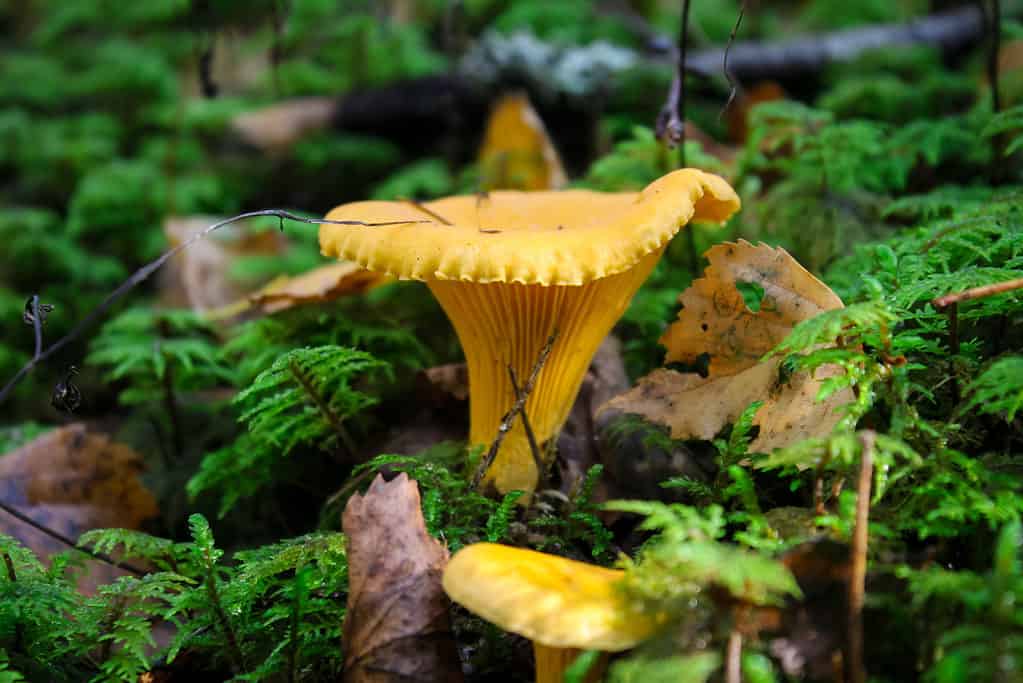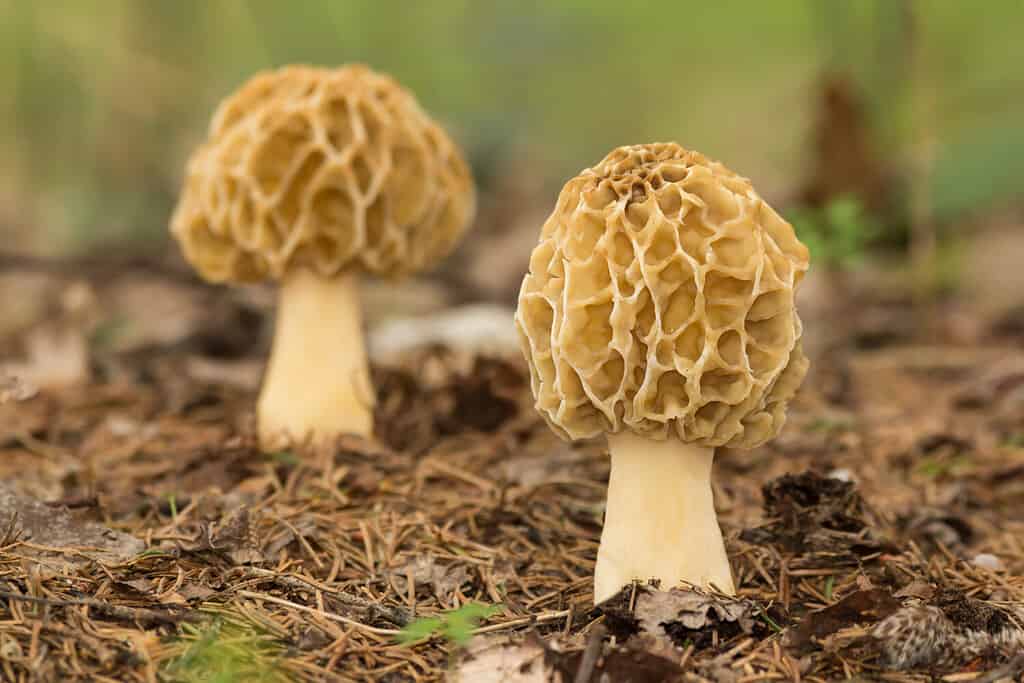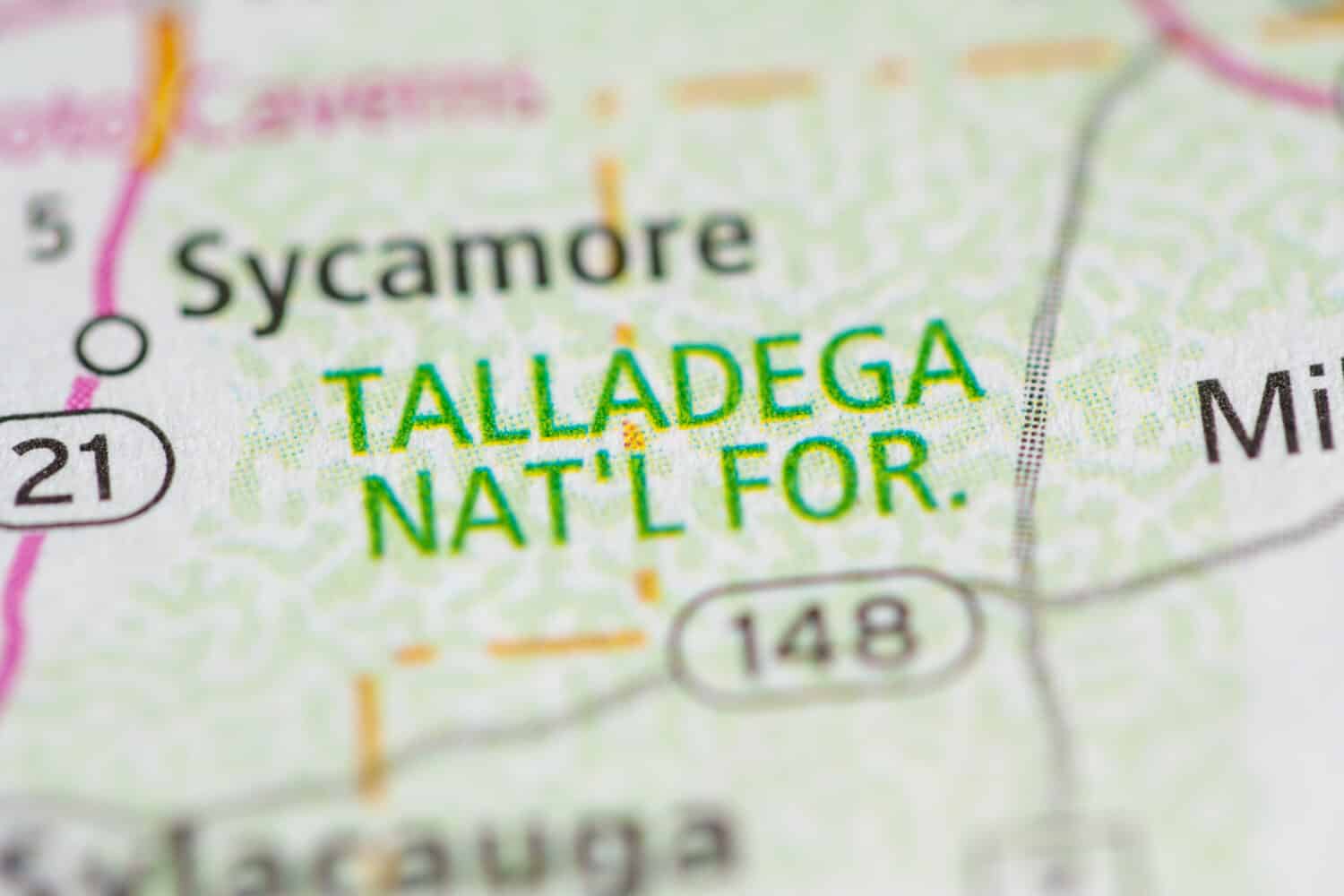Interested in mushroom hunting in Alabama? You’re in luck! Especially in the central and northern regions, popular mushroom species abound and thrive in the diverse ecosystems of the state. If you’re looking to get started foraging for mushrooms in Alabama, this guide will provide you with an overview of foraging guidelines, describe popular species to hunt for in the state and outline a couple of the best forests to hunt in.
Read on to learn more!
General Guidelines for Mushroom Hunting
Mushroom hunting provides an amazing opportunity for folks to interact with their natural environment, learn about local wild foods, and increase field skills in mushroom identification. If you’re new to the world of mushroom hunting, before going on your first foray it’s important to familiarize yourself with the following guidelines:
- For beginners, attending forays with a mushroom expert or local mycological club will increase how much you can learn on walks and better ensure your safety while foraging.
- Never consume a mushroom if you aren’t 100% sure of its identity as a safe, edible species. If you are unable to positively identify the mushroom on your own, you can send off a dried specimen to a lab for I.D. or find a local mushroom expert to consult with about your find in person. You can also sometimes find mycologists willing to help with identification on forums and mycology Facebook groups. Up-to-date field guides and online mycological dichotomous keys can assist with I.D.
- Wear practical clothing for foraging, including sturdy, closed-toed shoes. If you are going to walk in areas with high populations of ticks, wearing long pants tucked into socks is advised. Be aware of hunting seasons and wear bright orange accordingly.
- Reduce your impact on the environment while foraging. Avoid trampling sensitive areas, and try to stay on designated trails as much as possible.
- Be mindful of how many mushrooms you pick in one area. Remember that a plethora of other critters, such as deer, also use some species of mushrooms as a food source. Additionally, enough mushrooms need to remain to successfully disperse their spores.
What to Bring
Ideally, carry a woven basket or mesh bag to collect mushrooms. These allow spores to travel throughout the forest as you walk. Additionally, the ventilation helps keep the mushrooms fresh. Carry an up-to-date, well-respected field guide to assist with field identification. You may not be able to identify down to the species level on-site, but field guides can often help you narrow down to a genus or family. You’ll also want to bring a phone or camera for taking photos, which can help considerably with off-site identification. Always bring more water than you think you will need, and it never hurts to bring some snacks too. Especially if you’ll be spending hours in the forest, it’s always a good idea to pack a first aid kit.

Proper footwear is always a good idea before trekking into the woods.
©iStock.com/PIKSEL
Mushroom Hunting in Alabama: Popular Species to Forage
Before you embark on your foraging adventure, it’s a good idea to get to know the most popularly foraged mushrooms in the state. This is especially important if your goal is to hunt for delicious, edible species. Additionally, if you’ll be hunting for edible species, you’ll also want to familiarize yourself with any poisonous lookalikes that co-occur in the area.
Below, we’ll highlight three of the most popular types of mushrooms to forage in Alabama and any corresponding poisonous lookalikes. In addition to the featured three mushrooms below, other fungi that hunters in Alabama commonly forage for include:
- Oyster mushrooms (Pleurotus spp.)
- Hens of the woods (Grifola frondosa)
- Cauliflower fungus (Sparassis spp.)
- Black trumpets (Craterellus fallax)
- Indigo milk cap (Lactarius indigo)
Chanterelles (Cantharellus spp.)
One of the most abundant, and highly sought-after edible mushrooms in Alabama are chanterelles (Cantharellus spp.). These delicious, lovely mushrooms mostly occur in central and northern Alabama. You can find them growing individually, in small clusters, or in plentiful flushes across the forest floor. Chanterelles come in a range of colors, with the majority of species featuring golden-yellow fruiting bodies. Although, cinnamon-red species do occur. In Alabama, some of the most common species include the smooth chanterelles (C. lateritius), Cantharellus tabernensis, the Appalachian chanterelle (C. appalachiensis), cinnabar chanterelle (C. cinnabarinus or C. texensis), and Cantharellus lewisii.
Chanterelles form mycorrhizal associations with the roots of living trees. This means they derive their nutrients from a beneficial plant-fungi nutrient exchange. As such, you won’t find chanterelles growing from dead logs, weakened trees, wood chips, or manure. As mycorrhizal mushrooms, they don’t derive their nutrients from growing on decomposing organic matter.
Instead, they fruit directly from the forest floor as the underground portion of the fungus, the mycelium, weaves its way throughout the soil, sending up mushrooms near its mycorrhizal tree partners. You can find chanterelles fruiting from early summer through fall. They most commonly grow near hardwoods such as beech, oak, maple, birch, and poplar. Sometimes, you can also find them growing near pine and hemlock trees.
Identifying Features of Chanterelles
All members of the Cantharellus genus are edible. Here are some identifying features of this delicious genus:
- False gills. Rather than featuring paper-thing, delicate, and moveable gills, chanterelles feature primitive, or false, gills that appear more as rubbery ridges. They don’t easily move when brushed with your thumb, and they aren’t as paper-thin or delicate. Some species, such as the smooth chanterelle, have barely visible false gills. While others, such as the Appalachian chanterelle, have well-defined ridges.
- The false gills run down partially down the stipe (stem) of the mushroom, meaning they are decurrent.
- The majority of chanterelles are not hollow. However, many specimens of Cantharellus appalachiensis are at least partially hollow. Most Craterellus spp. are hollow.
- They typically tear easily vertically down the center.
- Many species of chanterelles smell fruity, specifically of apricot.
- The flesh of chanterelles does not change color when bruised or sliced but may brown some with age.
Poisonous Lookalikes
In Alabama, watch out for the following lookalikes:
- Jack o’ lantern mushrooms (Omphalotus illudens). The Omphalotus genus will cause quite intense and painful GI distress.
- False chanterelle (Hygrophoropsis aurantiaca). Some reports claim this species is mildly poisonous and most guides don’t recommend eating it.

We are slowly finding out that there is more and more species diversity in the genus
Cantharellusthan ever thought.
©iStock.com/Krot44
Mushroom Hunting in Alabama: Morels (Morchella spp.)
In the early spring, mushroom hunters in Alabama focus their efforts on the northern part of the state for a particularly sought-after type of mushroom: morels. True morels belong to the Morchella genus of mushrooms, and, in Alabama, occur north of the frost line. These cool-loving mushrooms are quite expensive to purchase and are well-loved for their rich, nutty taste.
These mushrooms feature conical-shaped caps that are pitted with a honeycomb-like structure. Mycologists place morels into three distinct evolutionary clades: rufobrunnea, esculenta, and elata. The corresponding common classifications of mushrooms are as follows: blushing or landscape morels belong to rufobrunnea, yellow morels correspond to esculenta, and black, burn-site, and half-free morels belong to the elata clade.
All true morels feature a hollow cap, pitted, honey-comb-like cap structure, and the majority have stipes that are fully attached to the cap. The exception is the small number of half-free morel species, such as Morchella semilibera, which feature caps that hang partially detached over the sides of the stipe.
Finding Morels in Alabama
In Alabama, the most common morel species are the eastern black morel Morchella angusticeps, tulip morel (Morchella diminutiva), and the common yellow morel (Morchella americana). Currently, there isn’t a widespread consensus among mycologists concerning whether morels form mycorrhizal partnerships. It is widely accepted, however, that they appear to form some kind of association with specific tree species and the majority do grow along the forest floor. The exception is the rufobrunnea clade, which appears to primarily derive its nutrients from decomposing organic matter. They tend to appear growing in woodchips or along trails in deeply aged mulched areas.
Morels of the esculenta clade tend to associate with hardwoods, particularly cottonwood, pear, apple, American elm, tulip poplar, and white and green ash trees. In Alabama, you’re most likely to find morels of the elata clade growing among tulip poplar, cherry, American elm, white and green ash, and aspen trees. They often occur scattered in hardwood forests in or near moss and on moist slopes.
Poisonous Lookalikes
In Alabama, the most significant co-occurring poisonous lookalikes are as follows:
- The false morel (Gyromitra esculenta)
- Korf’s false morel (Gyromitra korfii)

Always cook your morels thoroughly- many people get sick every year, and there have even been some deaths associated with undercooked morels.
©Luka Hercigonja/Shutterstock.com
Chicken of the Woods (Laetiporus spp.)
Sometimes in the spring and then again in the late summer and fall, mushroom hunters in Alabama often hit the trails in search of chicken of the woods (Laetiporus spp.). This colorful, delicious polypore mushroom grows as a parasitic and saprobic (decomposer) fungus on the wood of dead or weakened hardwood trees. They most commonly occur on oak, beech, and cherry trees. As a parasitic fungus, chicken of the woods causes brown rot, typically at the base or center of the host tree.
Identifying Features of Chicken of the Woods
When young, chicken of the woods is quite colorful, featuring bright yellow-orange wavy, thick caps. Often, you can see banding of yellow, orange, and white, especially on the margins of young specimens. Underneath, the pores of a young species are cream-colored to yellow, depending on the species. As the mushroom ages, the color of the cap and pores typically fades. Older specimens are often very pale orange with off-white pores.
In Alabama, the following four species of chicken of the woods occur:
- Laetiporus sulphureus
- L. cincinnatus
- L. gilbertsonii var. pallidus
- L. persicinus (may be removed from the genus pending genetic studies)
Poisonous Lookalikes
In the Southeast U.S., there is a mushroom that can look a lot like chicken of the woods to the untrained eye. Luckily Piptoporellus isn’t toxic, so it isn’t a dangerous look alike. As a result, Laetiprous is one of the best beginner-friendly mushrooms to forage for. And yes, most people do find that it tastes like chicken.

has been shown to be able to fight M.R.S.A. in a petri dish!
©Marc Venema/Shutterstock.com
Cooking Your Wild Mushrooms
Once you confirm the identity of an edible mushroom with 100% certainty, it’s time to cook ’em up! But while you may be tempted to fill your plate with these wild goodies, it’s best practice to only eat a small bite of a newly tried mushroom. Then, wait at least 24 hours to see how you feel before eating more. This is an excellent guideline as some people still have gastrointestinal reactions to commonly consumed mushroom species.
For example, some people have upset stomachs after eating Chicken of the Woods. However, this may be due to undercooking the mushrooms, which require at least 15 minutes of sauteing. Additionally, some mushrooms, like morels are quite toxic if they aren’t cooked. You should never eat raw morels or throw in dried morels at the end of cooking a soup. Morels, in particular, can cause serious health effects, including neuro-toxic effects, when eaten raw or undercooked.
Most people enjoy sauteing their wild, edible mushrooms in butter (vegan or dairy), with garlic and shallots. This is just a basic recipe, of course. You can create all kinds of wonderful dishes from wild mushrooms.

Many mushrooms are excellent additions to East Asian-style soups.
©Julia-Bogdanova/Shutterstock.com
Mushroom Hunting in Alabama: Best Places to Forage Across the State
It’s best to familiarize yourself with local regulations on mushroom foraging. Whether you can forage at all, and how much per day, varies across different state parks, national forests, and national parks. Some wild species are not allowed to be foraged in certain states or localities. Below, we’ll talk about two of the best places to hunt mushrooms in Alabama. These areas allow mushroom hunting, although specific regulations can vary and are subject to change.
Talladega National Forest
In the Talladega National Forest, located between Birmingham and Montgomery, you can forage up to five gallons of mushrooms per season without a permit. The “Incidental Use” rule allows you to have up to one gallon of mushrooms in your possession at a time. If you wish to forage for more than five gallons in one season, you’ll need to acquire a “Personal Use” permit. These permits are free and allow an individual to harvest up to five gallons of mushrooms per day, with a maximum of 20 gallons harvested per season.
The Talladega National Forest covers 392,567 acres. It encompasses the southern edge of the Appalachian Mountains. The range of habitats makes this national forest an excellent location to forage a range of Alabama’s mushrooms.

Talladega National Forest is one of a few public forests in Alabama that is well-known for allowing mushroom foraging.
©SevenMaps/Shutterstock.com
Mushroom Hunting in Alabama: Bankhead National Forest
Located between Birmingham and Huntsville, the Bankhead National Forest is an excellent location for morel foraging. The Alabama Mushroom Society periodically organizes forays in this beautiful forest. If you’re interested in joining a mycological club in Alabama, be sure to check out their website. As part of the national forest system, mushroom foraging regulations for Bankhead are likely the same as those for Talladega. To get the most updated information, you can always call a local office.
This gorgeous national forest consists of 181,230 acres and is home to Alabama’s only National Wild and Scenic River- the Sipsey Fork River. This national forest exists within the Cumberland Plateau and consists of high bluffs, sloping ridges, steep gorges, and freshwater valleys. It contains stands of large old-growth hardwood forests and pine-dominated areas.
Tuskegee National Forest
Located east of Tuskegee, Alabama, the Tuskegee National Forest covers 11,252 acres. While it is the smallest national forest in the United States, this area is still quite popular with mushroom hunters in central Alabama. This forest consists mostly of mixed pine and hardwood groves, with broad, gentle slopes and ridges, and floodplains featuring stream terraces and permanent wetlands. The sections of moist environments and mixed forests provide an excellent habitat for many species of mushrooms.
Mushroom Clubs in Alabama
Whether you’re new to the world of mushroom hunting or are an experienced forager, joining a mushroom club is an excellent way to connect and learn more about the wonderful world of mycology. In addition to the Alabama Mushroom Society, the North American Mycological Association also lists the North Alabama Mushroom Society and the Gulf South Mycological Society as active mushroom clubs in the region.
By joining one or more of these clubs, you’ll have access to online and in-person events, including activities such as lectures, classes, potlucks, and of course, forays.
There is even a “Mushroom Faire” that is thrown by the Alabama Mushroom Society. They feature well-known mycologists and all types of events conducive to learning more about mycology. More information can be found at Alabama Mushroom Faire.
The photo featured at the top of this post is © iwciagr/Shutterstock.com
The information presented on or through the Website is made available solely for general informational purposes. We do not warrant the accuracy, completeness, or usefulness of this information. Any reliance you place on such information is strictly at your own risk. We disclaim all liability and responsibility arising from any reliance placed on such materials by you or any other visitor to the Website, or by anyone who may be informed of any of its contents. None of the statements or claims on the Website should be taken as medical advice, health advice, or as confirmation that a plant, fungus, or other item is safe for consumption or will provide any health benefits. Anyone considering the health benefits of particular plant, fungus, or other item should first consult with a doctor or other medical professional. The statements made within this Website have not been evaluated by the Food and Drug Administration. These statements are not intended to diagnose, treat, cure or prevent any disease.
Thank you for reading! Have some feedback for us? Contact the AZ Animals editorial team.







